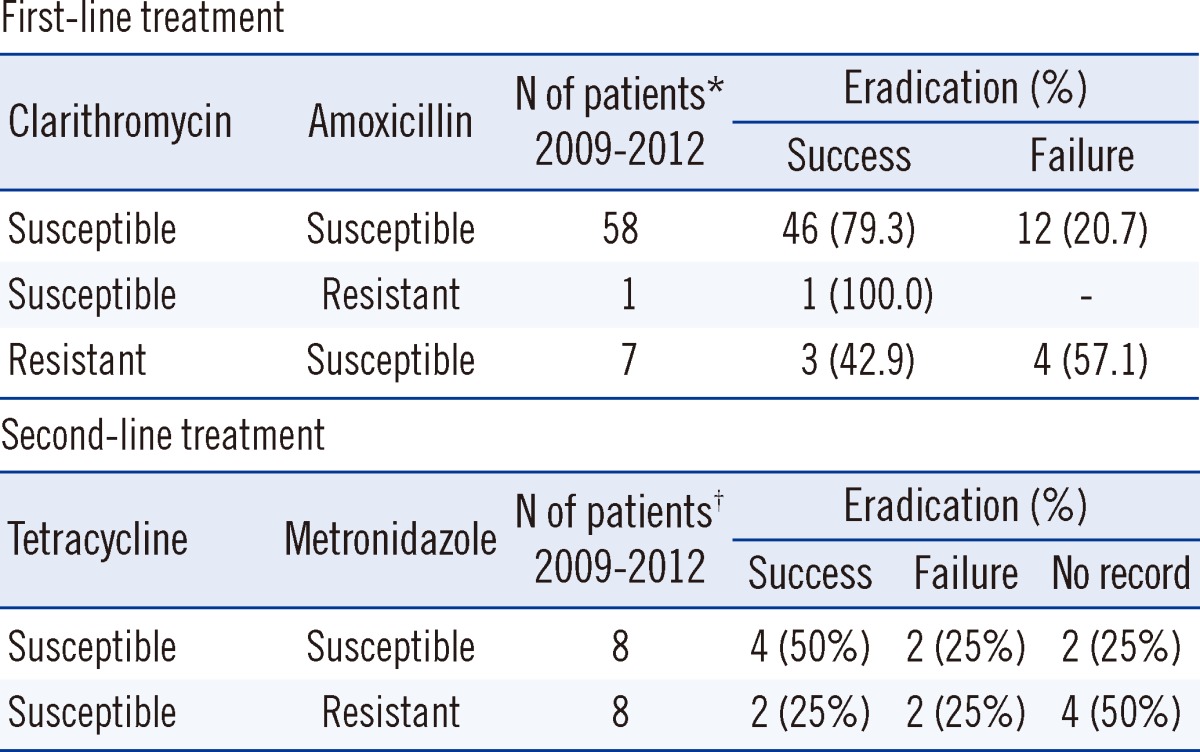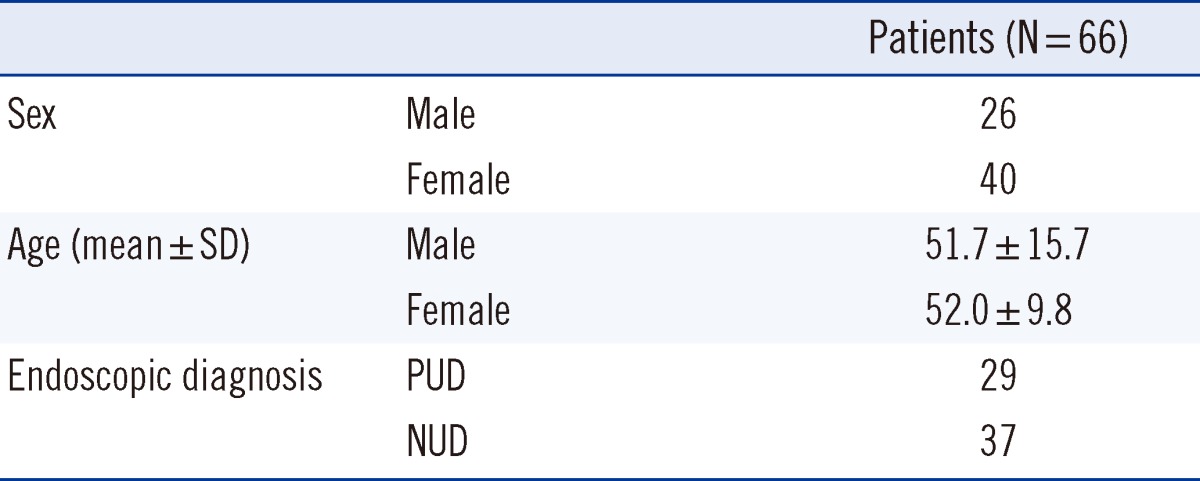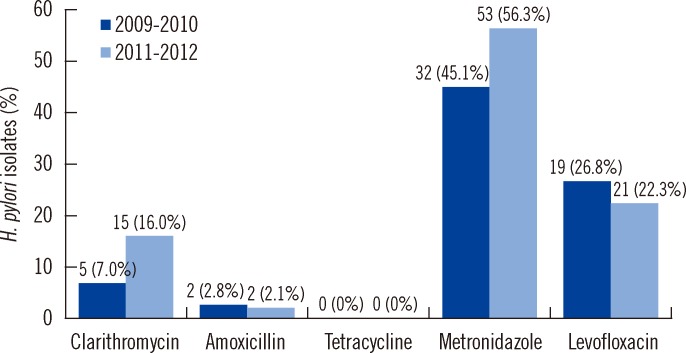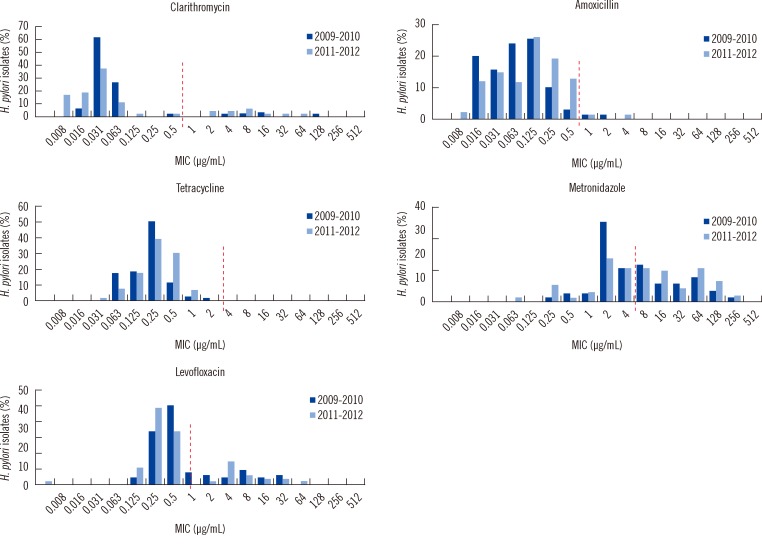1. Sugiyama T, Sakaki N, Kozawa H, Sato R, Fujioka T, Satoh K, et al. Sensitivity of biopsy site in evaluating regression of gastric atrophy after
Helicobacter pylori eradication treatment. Aliment Pharmacol Ther. 2002; 16(Suppl 2):187–190. PMID:
11966540.
2. Suerbaum S, Michetti P.
Helicobacter pylori infection. N Engl J Med. 2002; 347:1175–1186. PMID:
12374879.
3. Malfertheiner P, Megraud F, O'Morain C, Bazzoli F, El-Omar E, Graham D, et al. Current concepts in the management of
Helicobacter pylori infection: the Maastricht III Consensus Report. Gut. 2007; 56:772–781. PMID:
17170018.
4. Kim N, Kim JJ, Choe YH, Kim HS, Kim JI, Chung IS. Diagnosis and treatment guidelines for
Helicobacter pylori infection in Korea. Korean J Gastroenterol. 2009; 54:269–278. PMID:
19934608.
5. Hwang TJ, Kim N, Kim HB, Lee BH, Nam RH, Park JH, et al. Change in antibiotic resistance of
Helicobacter pylori strains and the effect of A2143G point mutation of 23S rRNA on the eradication of
H. pylori in a single center of Korea. J Clin Gastroenterol. 2010; 44:536–543. PMID:
20179610.
6. Choi YS, Cheon JH, Lee JY, Kim SG, Kim JS, Kim N, et al. The trend of eradication rates of first-line triple therapy for
Helicobacter pylori infection: single center experience for recent eight years. Korean J Gastroenterol. 2006; 48:156–161. PMID:
17047430.
7. Na HS, Hong SJ, Yoon HJ, Maeng JH, Ko BM, Jung IS, et al. Eradication rate of first-line and second-line therapy for
Helicobacter pylori infection, and reinfection rate after successful eradication. Korean J Gastroenterol. 2007; 50:170–175. PMID:
17885282.
8. Clinical and Laboratory Standards Institute. Performance standards for antimicrobial susceptibility testing. Eighteenth informational supplement, M2-A9, M7-A7, and M100-S18. Wayne, PA: Clinical and Laboratory Standards Institute;2008.
9. Glupczynski Y, Mégraud F, Lopez-Brea M, Andersen LP. European multicentre survey of in vitro antimicrobial resistance in
Helicobacter pylori. Eur J Clin Microbiol Infect Dis. 2001; 20:820–823. PMID:
11783701.
10. Kim JM, Kim JS, Kim N, Jung HC, Song IS. Distribution of fluoroquinolone MICs in
Helicobacter pylori strains from Korean patients. J Antimicrob Chemother. 2005; 56:965–967. PMID:
16159928.
11. Kim JM, Kim JS, Jung HC, Kim N, Song IS. Antibiotic resistance of
Helicobacter pylori isolated from Korean patients in 2003. Korean J Gastroenterol. 2004; 44:126–135. PMID:
15385720.
12. Kim JJ, Reddy R, Lee M, Kim JG, El-Zaatari FA, Osato MS, et al. Analysis of metronidazole, clarithromycin and tetracycline resistance of
Helicobacter pylori isolates from Korea. J Antimicrob Chemother. 2001; 47:459–461. PMID:
11266421.
13. Eun CS, Han DS, Park JY, Jeon YC, Hahm JS, Kim KS, et al. Changing pattern of antimicrobial resistance of
Helicobacter pylori in Korean patients with peptic ulcer diseases. J Gastroenterol. 2003; 38:436–441. PMID:
12768385.
14. Lee HK, Chae HS, Kang JO, Lee MK, Sung HS, Kim MN, et al. Multicenter study for the frequency of 23S rRNA point mutations associated with clarithromycin resistance in Helicobacter pylori in Korea. Korean J Clin Microbiol. 2008; 11:84–89.
15. Queiroz DM, Dani R, Silva LD, Santos A, Moreira LS, Rocha GA, et al. Factors associated with treatment failure of
Helicobacter pylori infection in a developing country. J Clin Gastroenterol. 2002; 35:315–320. PMID:
12352294.
16. Kim N, Kim JM, Kim CH, Park YS, Lee DH, Kim JS, et al. Institutional difference of antibiotic resistance of
Helicobacter pylori strains in Korea. J Clin Gastroenterol. 2006; 40:683–687. PMID:
16940878.
17. Versalovic J, Shortridge D, Kibler K, Griffy MV, Beyer J, Flamm RK, et al. Mutations in 23S rRNA are associated with clarithromycin resistance in
Helicobacter pylori. Antimicrob Agents Chemother. 1996; 40:477–480. PMID:
8834903.
18. Kim MH, Kim HS, Park SY, Park CH, Choi SK, Rew JS. Analysis of antimicrobial resistance of Helicobacter pylori in Gwangju, Chonnam Provinces. Korean J Helicobacter Up Gastrointest Res. 2012; 12:82–87.
19. Kim JY, Kim NY, Kim SJ, Baik GH, Kim GH, Kim JM, et al. Regional difference of antibiotic resistance of
Helicobacter pylori strains in Korea. Korean J Gastroenterol. 2011; 57:221–229. PMID:
21519175.





 PDF
PDF ePub
ePub Citation
Citation Print
Print






 XML Download
XML Download